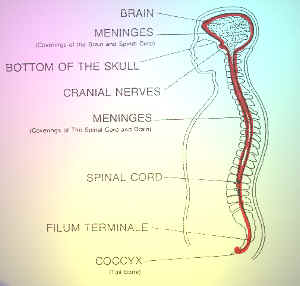|
...continued from page
2
The Simple Story
The simple story starts with the spinal column does not quite
work the way doctors have imagined it works and then fills
in as I have done below:
The first thing docs did not take into account was that if
your bones were lined up the way they were supposed to be
aligned, your body would stay upright with almost no effort
of the muscles (if you don't believe that see someone who
is competent at Advanced BioStructural Correction™ and
you can experience it -- so you do not have to believe those
before and after pictures on the first page of this web site).
Another thing they did not take into account and discover
was the mechanical role of the MENINGES (ma nin gees) and
the brain stem-spinal cord itself. The brain stem is the beginning
of the spinal cord and is not a separate thing. It is just
named separately because it is in the head. The meninges are
a tough elastic fibered sheath covering the central nervous
system – the spinal cord and brain.
You have probably heard of the meninges. They are the coverings
of the brain and spinal cord and commonly mentioned in relation
to infections called meningitis which means inflammation (hotness,
swelling, and redness) of the meninges.

Meninge is Latin for covering. The coverings
of the brain and spinal cord are called meninges (plural)
because there are three layers.
The meninges attach firmly to the inside of the skull surrounding
the brain. At the bottom of the skull where the brain stem
turns into the spinal cord and the cord goes down the back
of the spinal column, the meninges continue downward completely
encircling the cord and finally attaching firmly only at the
tail bone (coccyx).
The meninges do not attach firmly to the bones of the spinal
column but are attached to the bones of the spinal column
by elastic ligaments that are generally loose. They act like
bungee cords and stretch when the spinal cord moves too far
to one side. They act to keep spinal cord suspended in the
canal behind the front part of the bones which make the spinal
column (vertebrae, vert -a -bray).
Starting at the base of the skull the meninges have four
thick bands of tissue (front back and on each side) that are
thick and elastic like rubber bands.
These thick bands each act as a large rubber band would,
pulling from the tailbone (bottom of the spinal column) to
the head. When everything is in the correct place and you
are upright, the spinal cord and meninges are slack. When
you bend and everything is lined up correctly the spinal cord
and the bands of the meninges pull just enough to keep the
spinal column and your body stable. When you bend or get into
extreme positions they are stretched and pull even more. If
everything is aligned correctly in your spine the cord and
meninges come back to a slack position again when you straighten
and stand upright.
How much the vertebrae need to be out of place to cause
difficulty and the direction of misalignment that cause difficulty
are discussed elsewhere.
The main point is that the vertebrae get “stuck”
out of position and the body cannot self-correct their position
However, if the bones in your spine get stuck out of position
-- even slightly out of position -- then the spinal column
cannot hold itself upright as it should. That causes an abnormal
stretching of the cord and meninges to keep things together
and upright. You can experience this now by tucking your shirt
tightly into your pants or skirt in the back. Then bend your
body forward or even sideways or into a twist. The pulling
of the shirt in the back is the way the cord and meninges
are pulled as your body goes forward due to the inability
of the spine column to hold itself upright when vertebrae
are misaligned.
A quick review: The bones of the spinal column hold the body
upright with almost no muscular effort if they are correctly
aligned. When you are upright and the vertebra (bones of the
spinal column) are correctly aligned the spinal cord and meninges
are in a slack state. When you bend or move off center the
bones of the spinal column along with the skull and the meninges
act as a single system to hold the body stable. When you return
to center the vertebra again work to hold the body upright
with little or no effort of the muscles and no stretch of
the meninges or spinal cord.
When the bones of the spinal column are misaligned it results
in an uneven stretching or pulling of the cord and meninges
-- and maybe even some of the nerves coming off the spinal
cord or brain stem. The alignment is off so it causes stretching
and pulling of the brain stem and meninges up into the skull.
Many people feel this as headaches or tightness around their
head and eyes. Note in the picture above that the meninges
go up into head and attach firmly to the inside of the skull.
When they are stretched anywhere the tension is spread out
over the entire spinal column-skull-meningeal system. What
people feel depends on where the mechanical stress pulls the
most.
People can also feel this as nerve pinching lower in the
body. The reason this tension on the meninges, cord and brain
stem is felt in different places and affects people differently
is the difference in what bones they have out of place and
in what combinations of pulling they have.
continued on page
4...
top
|

